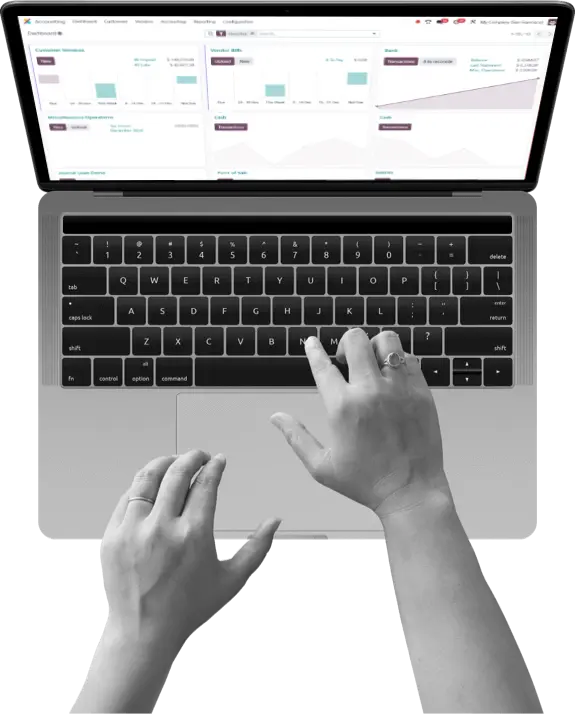Implementing an Enterprise Resource Planning (ERP) system is a significant investment for any business. With the potential to transform operations, improve efficiency, and drive growth, an ERP system like Odoo or SAP can be a game-changer. However, realizing these benefits requires more than just a successful deployment; it involves measuring and understanding the Return on Investment (ROI) to ensure that the system delivers the value you expect. In this blog, we’ll explore how to evaluate the ROI of your ERP system post-implementation and what factors to consider for a successful assessment.
1. Defining ERP ROI: What to Measure
Before diving into measurement techniques, it’s essential to understand what ERP ROI encompasses. ROI in the context of an ERP system typically includes:
- Cost Savings: Reduced operational costs due to increased efficiency and streamlined processes.
- Revenue Growth: Enhanced capabilities that contribute to higher sales and business growth.
- Productivity Gains: Time saved on manual tasks, leading to improved employee productivity.
- Quality and Accuracy: Fewer errors in data entry and processes, improving overall accuracy and decision-making.
To effectively measure ROI, businesses should consider both quantitative and qualitative metrics. Quantitative metrics are numerical and can be directly calculated, while qualitative metrics pertain to improvements in business processes and customer satisfaction.
2. Quantitative Metrics for Measuring ERP ROI
- Cost Reduction: Calculate the reduction in operational costs since implementing the ERP system. This could include savings on labor, material costs, and administrative expenses. Compare these figures to the pre-ERP implementation costs to gauge savings.
- Increased Revenue: Assess whether there has been a growth in revenue since the ERP system was implemented. Look at sales figures, market share, and customer acquisition rates to determine if the ERP system has contributed to business expansion.
- Productivity Improvements: Measure the increase in productivity by evaluating key performance indicators (KPIs) such as transaction processing times, order fulfillment rates, and employee output. Compare these metrics to pre-implementation benchmarks.
- Operational Efficiency: Analyze improvements in operational efficiency, such as reduced production times, better inventory management, and optimized supply chain processes. Look at metrics like inventory turnover rates, production cycle times, and order accuracy.
3. Qualitative Metrics for Measuring ERP ROI
- User Satisfaction: Gauge user satisfaction with the ERP system by conducting surveys and interviews. Assess how the system has impacted employee morale, ease of use, and overall job satisfaction.
- Process Improvement: Evaluate improvements in business processes. For instance, determine how the ERP system has streamlined workflows, reduced manual tasks, and enhanced cross-departmental collaboration.
- Customer Experience: Assess changes in customer experience and satisfaction. Look at metrics such as customer response times, order accuracy, and service delivery speed. Determine if the ERP system has contributed to a better customer experience.
- Strategic Advantage: Consider how the ERP system has provided a competitive edge. For example, improved data analytics capabilities might have enabled better strategic decisions or new business opportunities.
4. Conducting a Post-Implementation Review
A thorough post-implementation review is crucial for assessing ERP ROI. Follow these steps to conduct a comprehensive review:
- Gather Data: Collect data on all relevant metrics before and after ERP implementation. This includes financial reports, productivity statistics, and user feedback.
- Compare Results: Analyze the collected data to identify trends and changes. Compare pre- and post-implementation metrics to quantify the impact of the ERP system.
- Analyze Benefits vs. Costs: Weigh the benefits realized against the total cost of ownership (TCO) of the ERP system. TCO includes costs such as software licenses, implementation, training, maintenance, and support.
- Identify Areas for Improvement: Use the findings from the review to identify areas where the ERP system may not be meeting expectations. Look for opportunities to optimize the system and enhance its effectiveness.
- Communicate Results: Share the ROI results with stakeholders and team members. This helps in reinforcing the value of the ERP system and justifying the investment.
5. Leveraging ERP Analytics and Reporting
Most modern ERP systems, including Odoo and SAP, come with advanced analytics and reporting tools that can aid in measuring ROI. Utilize these tools to:
- Generate Reports: Create detailed reports on financial performance, operational efficiency, and other key metrics.
- Monitor KPIs: Set up dashboards to continuously monitor KPIs and track changes over time.
- Perform Data Analysis: Use data analysis features to gain insights into trends, patterns, and anomalies.
6. Case Studies and Real-World Examples
Looking at real-world examples and case studies can provide valuable insights into ERP ROI measurement. Here are a few examples:
- Case Study 1: A manufacturing company that implemented Odoo saw a 25% reduction in production time and a 15% increase in on-time delivery rates, leading to significant cost savings and improved customer satisfaction.
- Case Study 2: A retail business using SAP Business One experienced a 30% reduction in inventory carrying costs and a 20% increase in sales due to better demand forecasting and inventory management.
7. Continuous Improvement and Optimization
Measuring ROI is not a one-time activity but an ongoing process. Continually assess and optimize your ERP system to ensure it continues to deliver value. Regularly review performance metrics, seek user feedback, and stay updated with new features and updates that can further enhance your ERP system’s capabilities.
Conclusion
Understanding and measuring the ROI of your ERP system is essential for ensuring that your investment delivers the desired outcomes. By focusing on both quantitative and qualitative metrics, conducting thorough post-implementation reviews, and leveraging ERP analytics tools, you can gain a clear picture of the value your ERP system brings to your business. Remember, the goal is not just to measure success but to continuously improve and adapt your ERP system to meet evolving business needs and maximize ROI.
Are you currently evaluating the ROI of your ERP system? Share your experiences and insights in the comments below!

